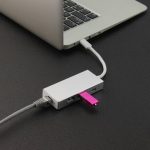USB 3.0 hubs offer you increased connectivity options by letting you connect multiple devices simultaneously, enhancing your workspace organization. With data transfer speeds up to 5 Gbps, you'll experience quick file transfers and improved workflow. They're lightweight and portable, making them perfect for travel. Plus, they're compatible with a wide range of devices and manage power efficiently. If you're curious about how these features can further elevate your setup, there's plenty more to explore.
Table of Contents
Key Takeaways
- USB 3.0 hubs enhance workspace organization by allowing simultaneous connections of multiple devices, reducing clutter and improving productivity.
- With data transfer speeds up to 5 Gbps, USB 3.0 hubs significantly decrease file transfer times and support multiple devices without slowing down.
- Their lightweight and compact design makes USB 3.0 hubs portable, perfect for travel and working from different locations.
- USB 3.0 hubs offer versatile compatibility with various devices, including laptops, smartphones, and printers, simplifying connectivity.
- Efficient power management features in USB 3.0 hubs reduce power drain and optimize energy usage, leading to lower electricity bills.
Increased Connectivity Options
With USB 3.0 hubs, you can instantly expand your device connections, making it easier than ever to manage multiple peripherals.
Instead of juggling limited ports on your computer, a USB 3.0 hub lets you connect several devices simultaneously. Whether you need to link a printer, an external hard drive, or a keyboard, you've got the flexibility to do so without hassle.
This increased connectivity means you can streamline your workspace and keep everything organized. Plus, with a hub's compact design, you won't sacrifice desk space.
You'll find that having multiple connections available not only enhances your productivity but also gives you the freedom to customize your setup according to your needs.
Embrace the convenience of expanded connectivity!
Enhanced Data Transfer Speeds
USB 3.0 hubs deliver impressive data transfer speeds that can significantly enhance your productivity. With speeds reaching up to 5 Gbps, you'll notice a dramatic reduction in file transfer times.
Whether you're backing up important files or moving large multimedia projects, these hubs make the process quick and efficient. You can connect multiple devices simultaneously without compromising speed, allowing you to transfer data from several sources at once.
This means less waiting and more doing, helping you stay focused on your tasks. Plus, the improved bandwidth reduces the chances of data bottlenecks, ensuring a smooth workflow.
Convenient Portability
When you're on the go, having a USB 3.0 hub that's easy to carry makes all the difference.
These hubs are typically lightweight and compact, fitting effortlessly into your bag or pocket. You won't have to worry about bulky devices weighing you down during travel.
Plus, their plug-and-play design means you can quickly connect and disconnect devices without any hassle.
The plug-and-play design allows for effortless connection and disconnection of devices, making your life easier on the go.
Whether you're working from a café or traveling for business, a portable USB 3.0 hub ensures you can access multiple devices simultaneously.
You'll enjoy the freedom to expand your connectivity options wherever you are.
With a reliable USB 3.0 hub by your side, you can stay productive without compromising on convenience.
Versatile Compatibility
Although you might have a range of devices, a USB 3.0 hub ensures seamless compatibility across them all. Whether you're connecting a laptop, tablet, or smartphone, these hubs work effortlessly with various operating systems. This versatility means you won't have to worry about finding the right connector for each device.
Here's a quick look at some common devices and their compatibility with USB 3.0 hubs:
| Device Type | Compatibility |
|---|---|
| Laptops | Yes |
| Smartphones | Yes |
| Tablets | Yes |
| Printers | Yes |
| External Drives | Yes |
With a USB 3.0 hub, you can easily connect all your gadgets without any hassle, streamlining your workflow and enhancing productivity.
Improved Power Management
Many users appreciate that USB 3.0 hubs not only offer versatile compatibility but also enhance power management.
These hubs efficiently distribute power across multiple connected devices, ensuring each one gets the energy it needs without overloading your system. This means you can connect more peripherals without worrying about power drain or device malfunction.
Plus, many USB 3.0 hubs come equipped with smart charging features, allowing for faster charging of smartphones and tablets.
You'll notice reduced energy consumption, which can help lower your electricity bills.
By choosing a USB 3.0 hub, you're not just expanding your connectivity options; you're also optimizing power usage, making your workspace more efficient and convenient.
It's a win-win for both productivity and sustainability.
Frequently Asked Questions
Can I Use a USB 3.0 Hub With USB 2.0 Devices?
Yes, you can use a USB 3.0 hub with USB 2.0 devices. They'll work together, but the devices will operate at their maximum USB 2.0 speed, not the faster USB 3.0 speeds.
How Many Devices Can I Connect to a USB 3.0 Hub?
You can connect multiple devices to a USB 3.0 hub, typically ranging from 4 to 10 ports. Just make sure your hub supports the number of devices you plan to connect for optimal performance.
Are USB 3.0 Hubs Compatible With All Operating Systems?
Yes, USB 3.0 hubs are compatible with most operating systems, including Windows, macOS, and Linux. You'll just need the appropriate drivers, which usually install automatically when you plug in the hub.
Do USB 3.0 Hubs Require an External Power Source?
USB 3.0 hubs don't always require an external power source; it depends on the hub's design and the devices you connect. For power-hungry devices, you'll need one to ensure optimal performance.
How Do I Choose the Right USB 3.0 Hub for My Needs?
To choose the right USB 3.0 hub, consider your device compatibility, the number of ports you need, and any additional features like charging capabilities. Assess your specific use case to find the perfect fit for you.




